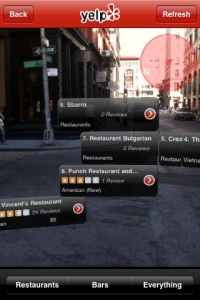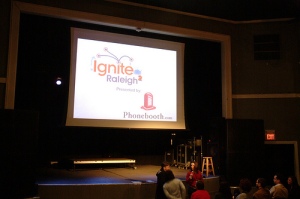So if you find the idea of location-based tools ridiculous and unessecary, here are a few shiny applications you can play with that might just get you hooked anyway. And if you already find the idea a compelling one, these goodies will get you going…
Gowalla
![]() Gowalla has applications for several mobile devices and they also have a mobile webpage (http://m.gowalla.com) for check-in. They do not currently have check-in available via their primary website. Gowalla uses the terminology “spots” for its check-in locations and can string together specific spots to complete a “trip”. Users can also earn “items” at check-in, some created for specific events (for example, the 2010 Winter Olympics).
Gowalla has applications for several mobile devices and they also have a mobile webpage (http://m.gowalla.com) for check-in. They do not currently have check-in available via their primary website. Gowalla uses the terminology “spots” for its check-in locations and can string together specific spots to complete a “trip”. Users can also earn “items” at check-in, some created for specific events (for example, the 2010 Winter Olympics).
FourSquare
 FourSquare allows users to check-in at various locations, both buildings and retail-based locations. Points are awarded based on when the user checks-in, the frequency of check-ins and whether the user has been to that location in the past. Those that frequent locations can become the “mayor” of that spot. Certain check-ins, or series of check-ins can earn the users “badges” which are displayed on their user profile indefinitely. Badges are very popular and there has been a great deal of interest in how badges are earned, and how to create new badges.
FourSquare allows users to check-in at various locations, both buildings and retail-based locations. Points are awarded based on when the user checks-in, the frequency of check-ins and whether the user has been to that location in the past. Those that frequent locations can become the “mayor” of that spot. Certain check-ins, or series of check-ins can earn the users “badges” which are displayed on their user profile indefinitely. Badges are very popular and there has been a great deal of interest in how badges are earned, and how to create new badges.
Yelp
![]() Yelp was not created as a location-based tool. Originally Yelp was kind of like the Yellow Pages for your phone. Looking for something? Search by name, characteristics, type of establishment, open hours, etc. to find what you need. Yelp also offers reviews and directions, plus information on other locations nearby. Over time Yelp expanded its features and it now includes the capacity to check-in to locations, however it lack many of the social connections and reward systems of other similar applications.
Yelp was not created as a location-based tool. Originally Yelp was kind of like the Yellow Pages for your phone. Looking for something? Search by name, characteristics, type of establishment, open hours, etc. to find what you need. Yelp also offers reviews and directions, plus information on other locations nearby. Over time Yelp expanded its features and it now includes the capacity to check-in to locations, however it lack many of the social connections and reward systems of other similar applications.
TriOut
 TriOut is an application local to the triangle-area in North Carolina. Tri-Out is built with FourSquare and actually includes the ability to update FourSquare check-ins via their application. In addition to location check-ins, TriOut will allow users to check-in to events, a neat twist on the location idea. While Tri-Out does not utilize badges or have mayors, frequent users can earn a “key” to locations.
TriOut is an application local to the triangle-area in North Carolina. Tri-Out is built with FourSquare and actually includes the ability to update FourSquare check-ins via their application. In addition to location check-ins, TriOut will allow users to check-in to events, a neat twist on the location idea. While Tri-Out does not utilize badges or have mayors, frequent users can earn a “key” to locations.
MyTown
 MyTown is a location-based application but in many respects it uses the concept quite loosely. Users can check-in to locations and they earn a combination of money and points each time. The money and points can then be used to “buy” locations that they have checked-in to and subsequently they can collect rent on these locations. The amount of rent available depends on the popularity of the spot and the number of check-ins by others. It’s a little like Monopoly, only with real locations.
MyTown is a location-based application but in many respects it uses the concept quite loosely. Users can check-in to locations and they earn a combination of money and points each time. The money and points can then be used to “buy” locations that they have checked-in to and subsequently they can collect rent on these locations. The amount of rent available depends on the popularity of the spot and the number of check-ins by others. It’s a little like Monopoly, only with real locations.
All these applications have a few features in common. The most important, at least from our business perspective, is the ability to post comments about locations (usually called “tips”) and share them with others. Businesses can also team with many of these applications to post news, information about promotions and rewards based on check-ins. These applications also include the ability to establish “friends”, other users of the application, with whom you can share your check-in status. You can also choose to post your check-ins to Facebook and/or Twitter. This opens debate for the idea of sharing too much information, a concern I’ll be addressing in a later post.
If this seems like a lot of checking in to do, it is! As you can imagine, no one checks into all these applications every time they go out of the house (ok, not very many people) so preferences in applications have begun to emerge. As of March 2010, Gowalla and FourSquare are the two duking it out for mobile-based application supremacy. While FourSquare has more users (500,000+ to Gowallas 150,000), Gowalla has won a number of awards and is increasing it’s numbers quickly. MyTown boast more that 1 million users but it’s not clear if that’s based on download of the application or actual check-ins. Yelp has a separate niche since it provides a great deal more information about the locations.
Tune in next week for more discussion about using these tools – the benefits and concerns for both businesses and personal users.






